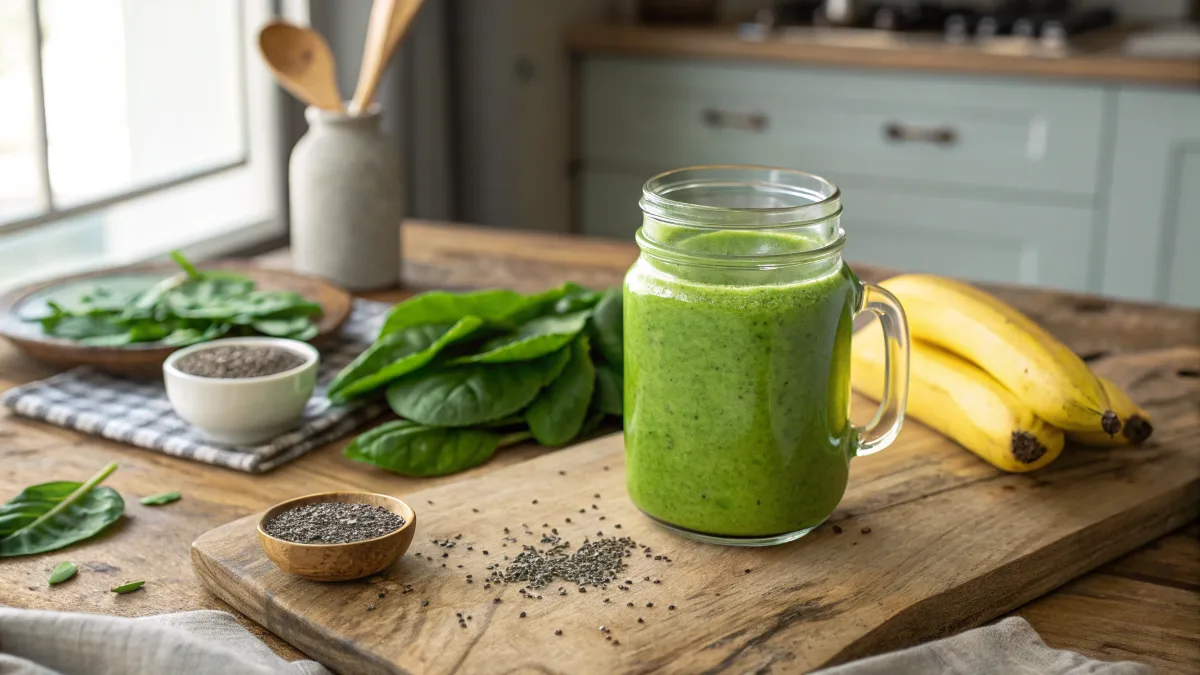Smoothie meal replacement is quickly becoming a go-to solution for anyone seeking a fast, nutritious, and convenient way to meet health goals without sacrificing time or flavor. Whether you’re aiming to lose weight, maintain muscle, or simply streamline your mornings, smoothie-based meals offer an easy and enjoyable alternative to traditional eating patterns. Blended with the right balance of nutrients, they can serve as a full meal—keeping you satisfied while fueling your body. With the growing popularity of clean eating and mindful nutrition, smoothie meal replacement plans are being adopted by everyone from busy professionals to fitness enthusiasts. In this article, we’ll break down how to get started, what to include, and how to achieve quick, lasting results.
Table of Contents
Understanding Smoothie Meal Replacements
What Is a Smoothie Meal Replacement?
A smoothie meal replacement is more than just a blended fruit drink—it’s a carefully crafted, nutrient-rich beverage designed to take the place of a full meal. Unlike regular smoothies that often focus on taste alone, smoothie meal replacements are built with the right balance of protein, healthy fats, fiber, and essential vitamins to keep you full, energized, and nourished. The goal is to mimic the nutritional value of a traditional meal while offering a quicker, more convenient format.
For many people, mornings are hectic, lunches are rushed, and dinners can feel like a chore. That’s where smoothie meal replacements shine. Instead of grabbing fast food or skipping meals entirely, you can whip up a delicious and balanced smoothie that fuels your body without requiring pots, pans, or even a plate.
But it’s not just about convenience. A well-formulated smoothie meal replacement can help regulate blood sugar, support digestion, promote weight loss, and improve energy levels. When done right, it becomes a powerful tool for a healthier lifestyle—especially when paired with thoughtful eating throughout the rest of the day.
The Science Behind Replacing Meals with Smoothies
Meal replacements have been studied for decades, and smoothies, in particular, have become a standout option because of their digestibility and versatility. The science behind smoothie meal replacements lies in macronutrient balance and caloric control. When you combine the three macronutrients—protein, fat, and carbohydrates—in the right proportions, your body feels full and satisfied for hours.
Protein is particularly important in smoothies because it boosts satiety and helps preserve lean muscle mass. Fiber, found in fruits, vegetables, chia seeds, and oats, slows digestion, balances blood sugar, and supports gut health. Meanwhile, healthy fats from ingredients like nut butter, avocado, or flaxseed provide long-lasting energy and help the body absorb fat-soluble vitamins.
Research shows that people who use meal replacements like smoothies tend to consume fewer calories overall and often see better results in weight management. These beverages are also easier to digest, making them an excellent option for people with sensitive stomachs or those recovering from illness.
Smoothies also offer an efficient way to deliver whole food nutrition. With a blender, you can pack in leafy greens, superfoods like spirulina or maca, antioxidant-rich berries, and even adaptogens—all in a single glass. You’re not just eating fewer calories—you’re getting more from each calorie.
Discover how smoothie nutrients enhance vitamin C absorption and fuel your daily energy.
Benefits of Using Smoothies as Meal Replacements
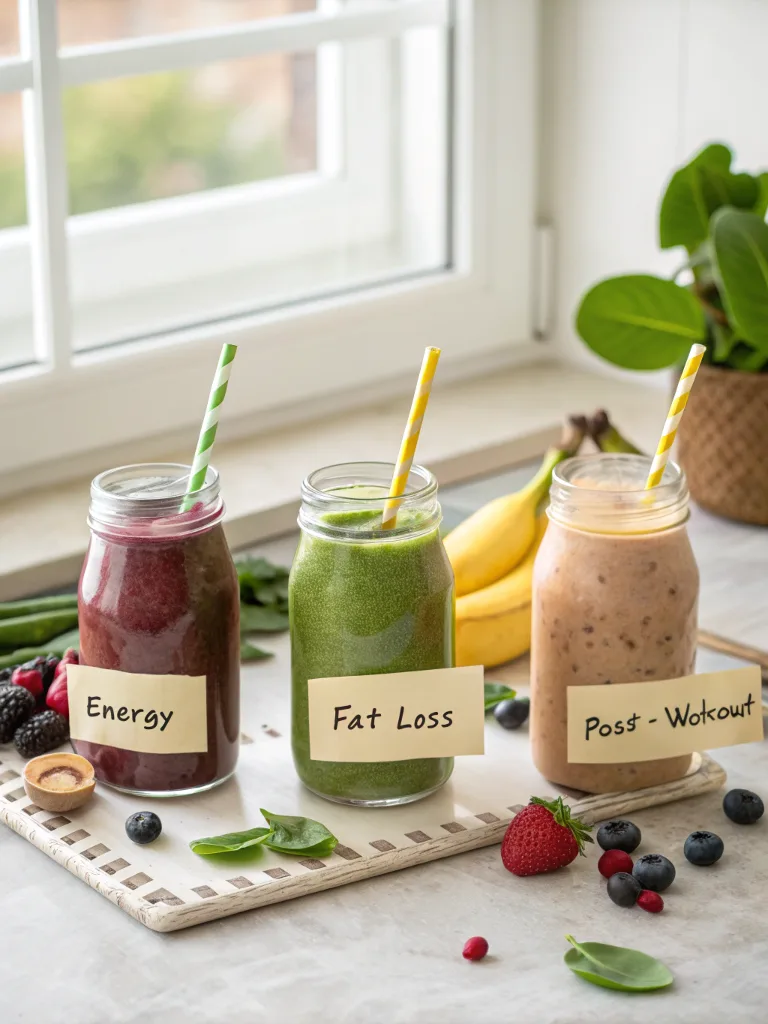
Weight Loss, Nutrient Density & Time-Saving Benefits
One of the biggest reasons people turn to smoothie meal replacements is for weight loss—and for good reason. They make it easier to manage portions and eliminate guesswork about calorie intake. Most weight-loss diets fail because people feel hungry, tired, or deprived. But when your meals are full of fiber, protein, and healthy fats, those problems tend to disappear.
Let’s break down some core benefits:
| Benefit | How Smoothie Meal Replacements Help |
|---|---|
| Weight Loss | Controls calorie intake and supports metabolism |
| Nutrient Density | Delivers vitamins, minerals, antioxidants |
| Time Efficiency | Quick to prepare and clean up |
| Customization | Easy to adjust for dietary needs (vegan, keto, etc.) |
| Portion Control | Reduces overeating with pre-set servings |
Smoothies also help prevent mindless snacking. Because they’re filling and flavorful, you’re less likely to reach for chips or sweets mid-afternoon. Plus, many ingredients support metabolic function, such as green tea, cinnamon, ginger, or MCT oil.
From a nutritional standpoint, smoothies outperform most processed meal replacements (like bars or powders) because they rely on whole foods. You’re getting real fruits, vegetables, seeds, and more—making it easier for your body to absorb and use the nutrients effectively.
Ideal for Busy Mornings or Post-Workout Recovery
Time is one of the most cited barriers to healthy eating. When you’re juggling work, kids, and life’s chaos, preparing three nutritious meals a day can feel impossible. That’s where smoothie meal replacements save the day.
In the morning, a high-protein green smoothie with berries and oats can set a positive tone. After a workout, a banana-peanut butter smoothie with protein powder helps restore glycogen and repair muscle. They’re perfect for busy people who still want to prioritize health.
Plus, smoothies are portable. Toss it in a shaker cup or insulated bottle, and you’ve got a nourishing meal on the go. Whether you’re commuting, hiking, or working a long shift, your smoothie is right there with you.
If you enjoy creamy blends, try the Smoothie King Angel Food Recipe for a sweet and satisfying option.
Explore more dairy-free alternatives with our smoothie recipes without yogurt.
How To Build a Complete Smoothie Meal Replacement
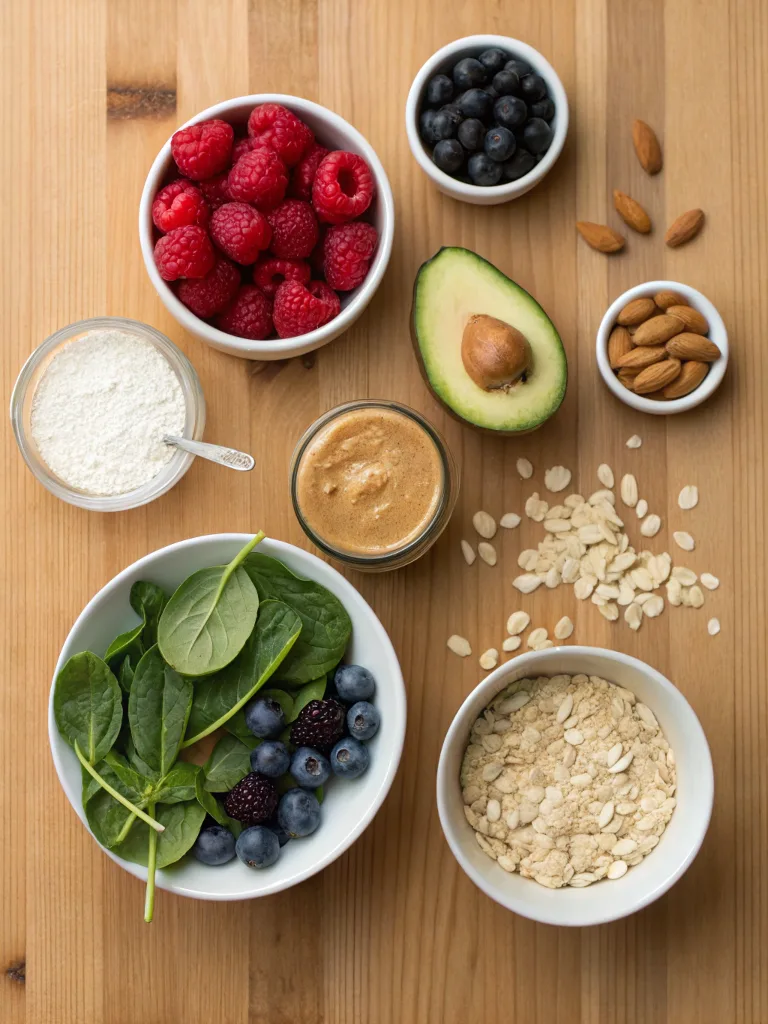
Key Nutrients Every Replacement Smoothie Must Have
The foundation of any successful smoothie meal replacement is nutrient balance. You’re not just blending fruit and calling it a meal. Here’s what every complete smoothie should contain:
- Protein (15–30g): Builds muscle, increases fullness
- Healthy Fats (5–15g): Supports hormones and energy
- Fiber (5–10g): Aids digestion and stabilizes blood sugar
- Complex Carbs (15–30g): Provides fuel and satisfaction
- Micronutrients: Vitamins, minerals, antioxidants
- Hydration Base: Water, almond milk, coconut water, etc.
By balancing these macronutrients, you create a smoothie that mimics the function of a balanced plate—and keeps your body in optimal mode all day.
Sample Ingredients: Protein, Fiber, Healthy Fats & Superfoods
To make it easier, here’s a breakdown of ingredients you can mix and match:
| Category | Examples |
|---|---|
| Protein | Greek yogurt, protein powder, tofu, hemp seeds |
| Fiber | Chia seeds, flaxseed, oats, spinach |
| Healthy Fats | Almond butter, avocado, coconut oil |
| Carbs | Banana, sweet potato, berries, quinoa |
| Superfoods | Maca powder, spirulina, matcha, turmeric |
| Liquid Base | Almond milk, oat milk, coconut water |
You don’t need to get fancy with every smoothie. Stick to 5–7 ingredients that balance flavor and nutrition. A good rule of thumb is: one protein source, one fat, one fiber, one fruit, one green, and a superfood for added punch.
Fruit smoothies no yogurt are perfect for a light, refreshing alternative.
Are Smoothies a Good Meal Replacement?
When They Work and When They Don’t
Smoothie meal replacement plans work beautifully—when you do them right. They’re especially effective when used to replace one meal per day, ideally breakfast or lunch. These are times when people often eat in a rush or skip meals entirely. A smoothie can step in to fill that nutritional gap without compromising on health.
But there are pitfalls too. If your smoothie is mostly sugar (think just fruit and juice), you’ll crash quickly and feel hungry soon after. It’s also easy to drink too few calories, leaving you unsatisfied and prone to binge later in the day. That’s why it’s important to treat your smoothie as a full meal, not a light snack.
Smoothie-only diets, while trendy, aren’t sustainable for everyone. Most people do better with a hybrid approach—using smoothies to replace one or two meals while eating whole food meals otherwise.
Comparing Smoothies to Traditional Meals
| Factor | Smoothie Meal Replacement | Traditional Meal |
|---|---|---|
| Prep Time | Under 5 minutes | 15–45 minutes |
| Portability | Excellent | Limited |
| Nutrient Control | High | Variable |
| Satiety | High (when balanced) | High |
| Versatility | Extremely customizable | Moderate |
Ultimately, smoothies work best as strategic tools, not all-day solutions. Used wisely, they support weight loss, muscle gain, and busy schedules better than most alternatives.
Creating Your 21-Day Smoothie Meal Replacement Plan
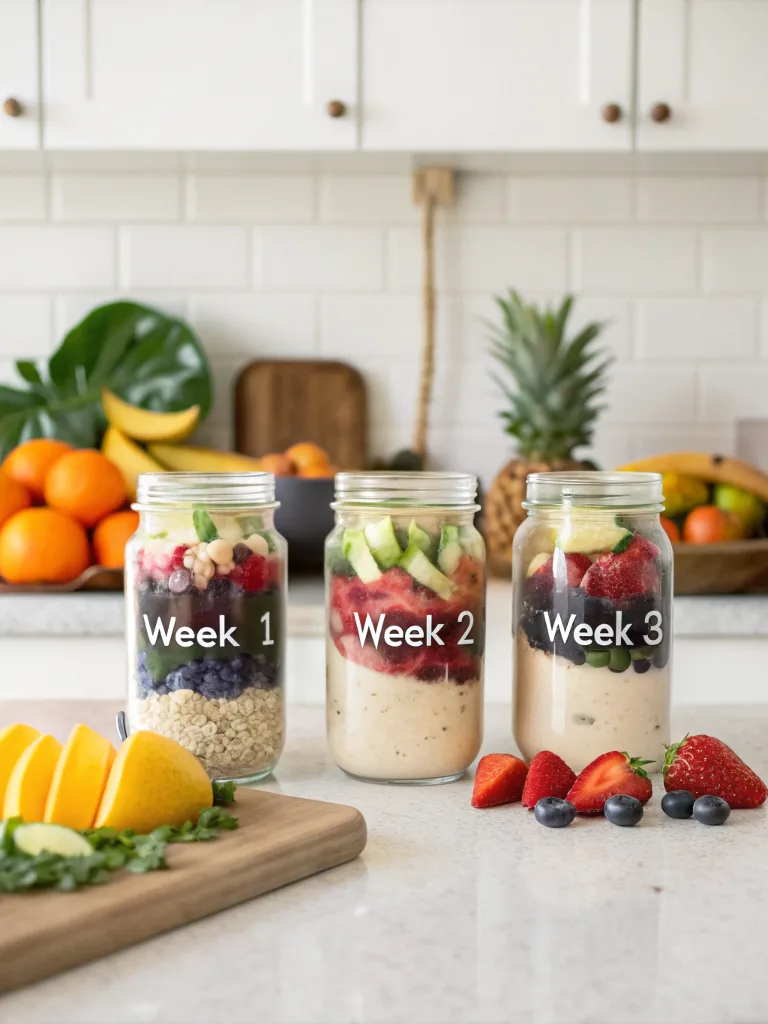
3-Week Weight Loss Schedule & Daily Smoothie Ideas
One of the most popular and effective ways to use smoothies for weight loss is the 21-day smoothie diet. The idea is simple: replace one or two meals per day with nutrient-dense smoothies for three weeks, while eating one balanced, whole-food meal daily.
Here’s a sample schedule:
| Week | Meal Plan | Focus |
|---|---|---|
| Week 1 | Replace 1 meal/day | Adjusting and detoxifying |
| Week 2 | Replace 2 meals/day | Fat burn acceleration |
| Week 3 | Replace 1–2 meals/day | Maintenance and sustainability |
Daily Smoothie Examples:
- Breakfast: Spinach + banana + almond butter + protein powder + oat milk
- Lunch: Mixed berries + flax + Greek yogurt + matcha + water
- Dinner (Whole Meal): Grilled chicken, sweet potato, kale salad
Snacks should be optional and healthy—think a handful of almonds or carrot sticks with hummus. Hydration is critical, so drink plenty of water throughout the day.
Tracking Progress: Energy, Weight, Cravings
As you go through the plan, keep a simple journal. Note how you feel each day—your energy levels, digestion, mood, and especially cravings. You’ll likely find that sugar cravings drop within the first week, and your body starts asking for more nutritious foods naturally.
Weigh yourself no more than once per week. The scale can fluctuate, but what matters is how your clothes fit, how your body feels, and your relationship with food.
Start your mornings with the Tropical Smoothie Sunrise Sunset for vibrant flavors.
Common Mistakes to Avoid With Smoothie Meal Replacements
Overloading on Sugar or Skipping Protein
While smoothies might seem foolproof, it’s surprisingly easy to make one that works against your goals. One of the most common mistakes is tossing in multiple fruits, sweetened yogurts, and juices—resulting in a sugar-packed drink that spikes blood sugar and leaves you crashing within hours. If your smoothie tastes more like a dessert, it’s time to rethink your formula.
Another critical issue? Not including enough protein. A smoothie with just fruit and milk won’t cut it as a meal replacement. Protein is essential to slow digestion, support metabolism, and keep hunger at bay. Without it, your smoothie becomes a temporary fix—not a lasting solution.
So what’s the fix? Aim for balance. Combine fruit with leafy greens, a scoop of protein (like plant-based or whey), healthy fats, and fiber-rich ingredients. This way, you’re creating a smoothie that fuels your body instead of draining it.
Not Listening to Your Body’s Hunger Signals
It’s tempting to treat a smoothie plan as a rigid system: drink X number per day and expect results. But everyone’s body responds differently. Some people thrive replacing two meals a day. Others feel drained or irritable if they go too long without solid food.
Listen to your body. If you’re constantly hungry after your smoothie, try increasing the protein or adding fiber like chia seeds. If you feel bloated or sluggish, reduce your serving size or remove heavy add-ins like nut butter. Smoothie meal replacements should feel energizing—not restrictive.
Remember, this isn’t about punishment or deprivation. It’s about nourishment, balance, and creating habits that fit your lifestyle.
Smoothie Meal Replacement for Different Lifestyles
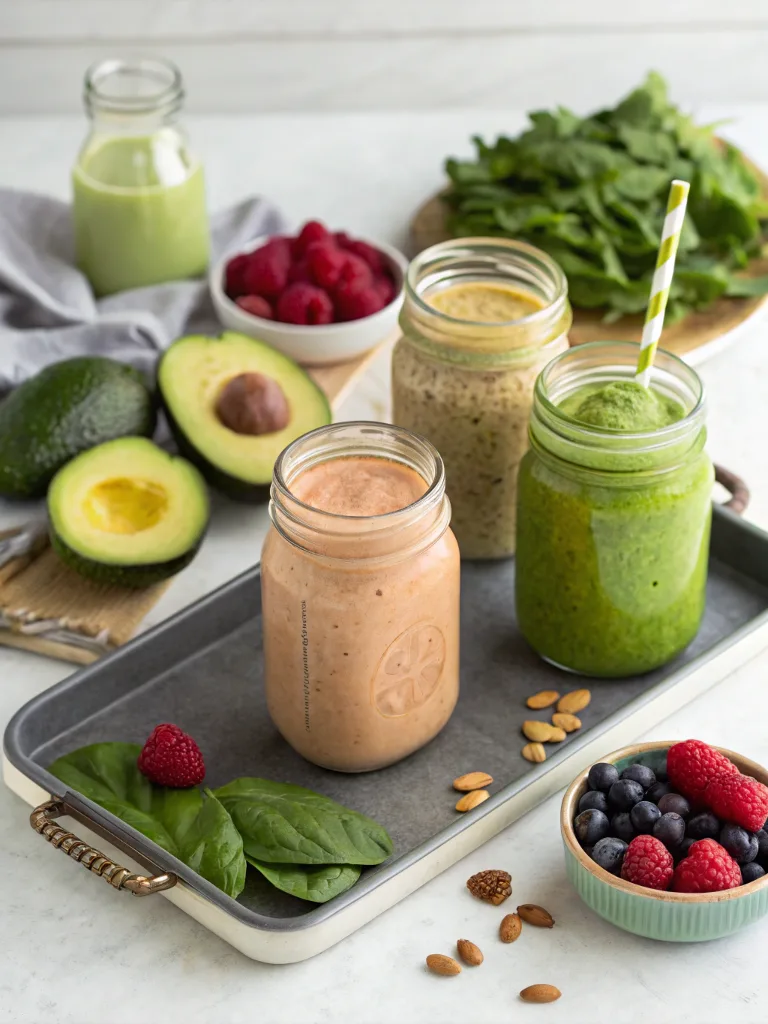
Vegan, Keto, High-Protein, or Low-Carb Adjustments
The beauty of smoothies is that they’re infinitely customizable. Whether you follow a vegan, keto, or high-protein diet, there’s a smoothie formula that fits your nutritional needs.
Let’s explore some tailored approaches:
| Lifestyle | Smoothie Adjustments |
|---|---|
| Vegan | Use plant-based milk, pea or hemp protein, nut butters, seeds |
| Keto | Focus on avocado, coconut milk, MCT oil, spinach, low-carb berries |
| High-Protein | Include Greek yogurt, whey or casein protein, oats |
| Low-Carb | Limit banana, use zucchini or cauliflower, add chia or flax |
These flexible formats help maintain consistency in your diet while still making smoothies exciting and flavorful. Plus, you’re in control of what goes into every blend.
Smoothies for Seniors, Teens, or Athletes
Smoothie meal replacement plans are not one-size-fits-all. Different age groups and lifestyles have unique needs.
- Seniors may benefit from smoothies rich in calcium, vitamin D, and protein to support bone health. Try blending Greek yogurt with berries, almond butter, and oat milk.
- Teens need energy for growth and activity. Add banana, peanut butter, spinach, and milk for a nutrient-packed option.
- Athletes should focus on post-workout recovery. Include fast-digesting carbs (banana, mango), high-quality protein (whey or pea), and anti-inflammatory add-ins like turmeric or ginger.
By adjusting ingredients based on life stage and activity level, smoothies can become one of the most functional meals of the day—no matter who you are.
Expert Tips to Maximize Results Fast
Best Times to Drink Meal Replacement Smoothies
Timing can make a big difference when using smoothies strategically. While there’s no wrong time to enjoy one, certain windows are especially effective:
- Morning (7–9am): Start your metabolism with a fiber-rich smoothie that provides lasting energy
- Post-Workout (within 30 minutes): Replenish glycogen and support muscle repair with a combo of carbs and protein
- Mid-Afternoon (2–4pm): Fight the slump and prevent unhealthy snacking with a light, refreshing smoothie
When you align smoothie timing with your body’s natural rhythm, you enhance energy, mood, and productivity throughout the day.
How to Meal Prep Smoothies for the Week
One major advantage of smoothie meal replacements is that they’re easy to prep in advance. Here’s how to simplify your weekly routine:
- Prep Ingredient Packs: Pre-measure fruits, veggies, and superfoods into freezer bags for grab-and-blend convenience
- Batch Your Base: Make a large container of your favorite smoothie liquid (like almond milk + cinnamon + vanilla)
- Use Mason Jars: Store blended smoothies in sealed jars (up to 2 days refrigerated)
- Keep Dry Ingredients Separate: Add protein powders, seeds, or oats right before blending to maintain texture
This system cuts down on daily prep time and ensures you stay consistent with your plan—even on busy mornings or late nights.
Real Success Stories & Sample Recipes
Reader Testimonials & Weight Loss Journeys
Real stories bring real inspiration. Meet Jenna, a 32-year-old mom of two who lost 12 pounds using a 21-day smoothie meal replacement plan.
“I used to skip breakfast, snack all day, and feel exhausted by 3 PM. Once I started replacing breakfast and lunch with smoothies, everything changed. I had more energy, fewer cravings, and I finally fit into my old jeans!”
Then there’s Marcus, a fitness coach who uses smoothies to maintain his lean physique:
“After workouts, I down a smoothie loaded with berries, protein, and almond butter. It’s easy, fast, and I never feel bloated. Best of all—it’s consistent.”
These stories are proof that smoothies aren’t just a trend—they’re a real lifestyle upgrade.
3 Balanced Smoothie Recipes (Breakfast, Lunch, Dinner)
To get you started, here are three simple, balanced recipes:
| Meal | Ingredients | Nutrition Highlights |
|---|---|---|
| Breakfast | 1 banana, 1 tbsp peanut butter, 1 scoop protein, 1 cup oat milk, 1 tsp chia | High fiber, protein-rich |
| Lunch | 1/2 avocado, 1/2 cup pineapple, spinach, coconut water, 1 tbsp flaxseed | Anti-inflammatory, hydrating |
| Dinner | Mixed berries, Greek yogurt, almond butter, oats, cinnamon | Balanced carbs, protein, and fat |
Each of these recipes is quick, delicious, and supports your journey toward better health with the smoothie meal replacement approach.
The Sunrise Sunset Smoothie is another variation that supports your goals.
FAQ About Smoothie Meal Replacement
Are smoothies a good meal replacement?
Yes, when made with the right balance of protein, fiber, fats, and carbs, smoothies can serve as an effective meal replacement. They offer convenience and help manage weight while keeping you nourished.
Can a smoothie be a complete meal?
Absolutely. A complete meal smoothie includes protein (like whey or tofu), healthy fats (like avocado or flax), fiber (from chia or greens), and complex carbs (like oats or banana).
Can you replace all meals with smoothies?
While it’s possible short term, replacing all meals may not be sustainable long term. It’s often healthier to replace one or two meals daily and enjoy a whole food dinner.
Can I lose weight on a smoothie diet?
Yes. Many people experience weight loss due to calorie control and improved nutrition. Just make sure your smoothies aren’t loaded with sugar.
How many pounds can I lose on the 21-day smoothie diet?
Results vary, but some people lose between 8–15 pounds depending on activity level, consistency, and starting weight.
Can I just drink smoothies instead of eating?
You can for a limited period, but combining smoothies with whole meals ensures you’re getting a wide range of nutrients and keeps your body in balance.
Conclusion
Smoothie meal replacement strategies aren’t just a fad—they’re a sustainable, practical path to better nutrition, weight control, and daily energy. With the right ingredients, timing, and approach, smoothies can transform how you fuel your body—without the hassle of meal prep or kitchen cleanup.
From customizing recipes to prepping in advance and tracking your progress, everything you need is just a blender away. Whether you’re looking to shed pounds, support your active lifestyle, or simplify healthy eating, smoothie meal replacements offer a flavorful and effective solution.
Looking for inspiration? The Bahama Mama Tropical Smoothie is a delicious way to mix up your rotation. You can also Expand your routine with our collection of Smoothie King Recipes.
Check out this hearty Blackstone Breakfast if you want to alternate with solid meals.
Add variety with recipes like the Deconstructed Burger Bowl—full of texture and flavor.
Loved this smoothie meal replacement guide? Let’s stay connected!
For daily recipe inspiration, meal prep ideas, and healthy smoothie tips, follow us on Facebook, check out fresh boards on Pinterest, or join the conversation on Twitter.
We share new smoothie ideas every week—see you there!
Still hungry for more smoothie meal replacement ideas?
Head over to this excellent guide on Simple Green Smoothies for additional recipes and tips from fellow smoothie enthusiasts.

